
Date: July 11, 2021
Location: Lat: 35.051091°, Lon: -48.969953°
Dive depth range: 939 - 1,272 meters (3,081 - 4,173 feet)
Access Dive Summary and ROV Data
During our exploration of MacGregor Seamount on the eighth dive of the 2021 North Atlantic Stepping Stones expedition, we explored along the face of a near-vertical wall that may have been the remnants of an old volcanic cone that has since been eroded away. Given that the Corner Rise Seamounts were formed by hotspot volcanism around 75 million years ago, this could indeed be a rather old feature! In addition to being impressive from a geological perspective, the wall was also home to a diversity of corals, with dense patches of soft corals in the genus Chyrsogorgia and exceptionally large colonies of octocorals in the genus Thourella dotting the wall, with interspersed Iridiogorgia sp. corals as well. Video courtesy of NOAA Ocean Exploration, 2021 North Atlantic Stepping Stones: New England and Corner Rise Seamounts. Download largest version (mp4, 54.8 MB).
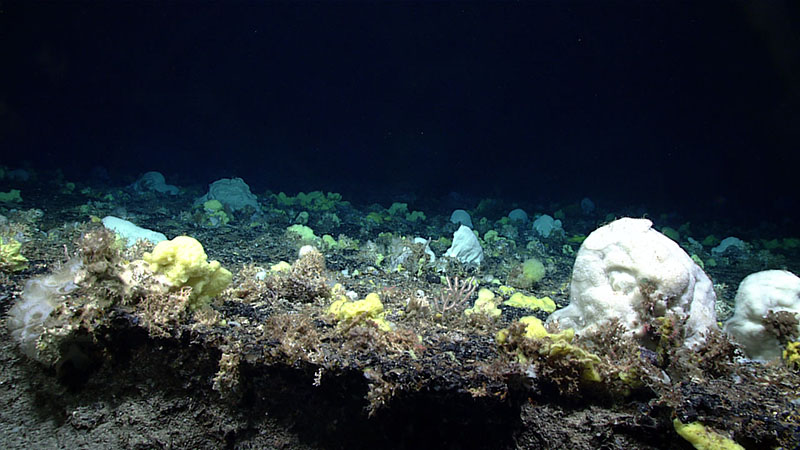
During Dive 08 of the 2021 North Atlantic Stepping Stones expedition, we observed a large and extensive sponge garden at the top of a carbonate reef platform, alongside reef-building hard corals and associated fauna. Shown here is an erosional ledge feature that may have once been a shoreline. Image courtesy of NOAA Ocean Exploration, 2021 North Atlantic Stepping Stones: New England and Corner Rise Seamounts. Download largest version (jpg, 1.1 MB).
Dive 08 was the shallowest dive of the 2021 North Atlantic Stepping Stones expedition thus far, as we explored MacGregor Seamount, starting at a depth of approximately 1,270 meters (4,167 feet). The primary objective of this dive was to explore and characterize ecological conditions and geological features of this unexplored seamount within the Corner Rise Seamount Chain.
The dive started on coarse sediment near the base of a very steep, near-vertical wall. The wall itself was continuous and not rugged, with many holes in the rock indicative of an ancient reef platform. We then moved to the flat upper surface of a carbonate platform, which had a thin layer of sediment over sporadically exposed rocks, indicating sustained strong currents were preventing the volume of sediment accumulation that might be expected for a feature of this age.
Biological communities were diverse in different areas of the dive. The diversity of deep-sea corals was greatest along the carbonate wall. Though sponges were represented on the sediment and along the vertical face of the wall in mostly small numbers and sizes, at the top of the carbonate wall, we encountered a large sponge garden, with innumerable diversity and high densities of sponges. Associate organisms were present throughout the dive as well, particularly echinoderms, and, for a change of pace, we saw fish throughout the dive as well.
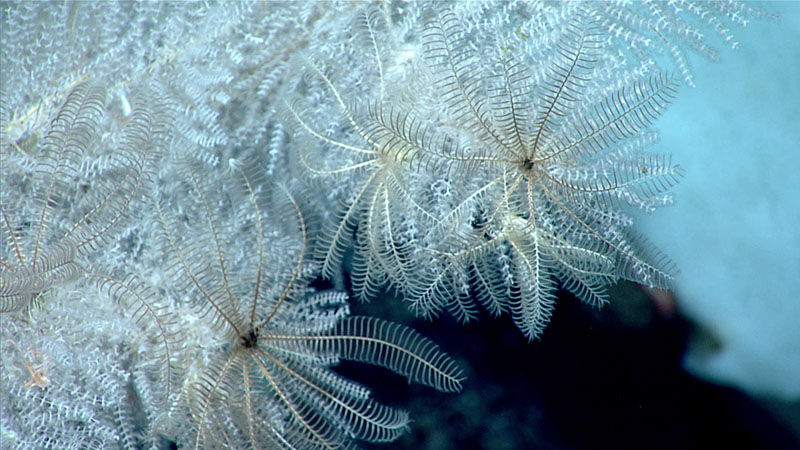
Several crinoids were seen living in the branches of a primnoid octocoral during Dive 08 of the 2021 North Atlantic Stepping Stones expedition. By living in the branches, the crinoids get a boost off the seafloor and are higher in the water column, where they have better access to food drifting by. Image courtesy of NOAA Ocean Exploration, 2021 North Atlantic Stepping Stones: New England and Corner Rise Seamounts. Download largest version (jpg, 1.2 MB).
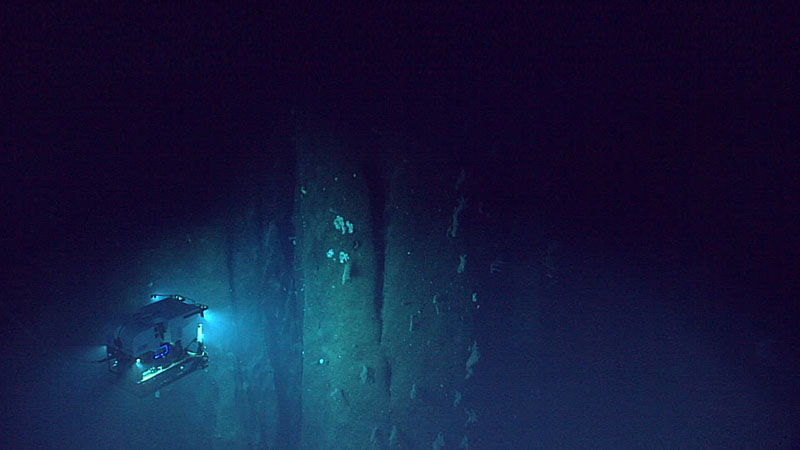
Remotely operated vehicle Deep Discoverer traverses the steep wall of the paleo-reef structure explored during the eighth dive of the 2021 North Atlantic Stepping Stones expedition. Dense patches of soft corals in the genus Chyrsogorgia and exceptionally large colonies of octocorals in the genus Thourella dotted the wall, with interspersed Iridiogorgia sp. corals as well. Along the wall, we collected a sample of an unknown plexaurid octocoral species. Image courtesy of NOAA Ocean Exploration, 2021 North Atlantic Stepping Stones: New England and Corner Rise Seamounts. Download largest version (jpg, 671 KB).
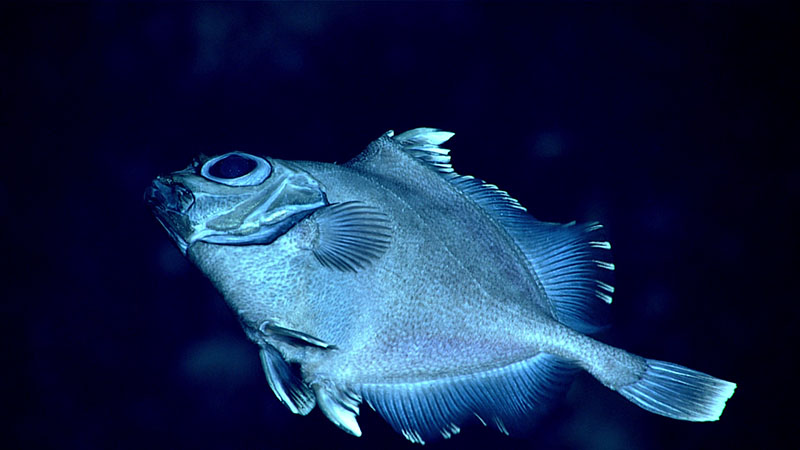
Oreo fish, also known as false boarfish, were seen throughout Dive 08 of the 2021 North Atlantic Stepping Stones expedition. This one was observed at a depth of 1,220 meters (4,003 feet). During this dive, we saw the most fish observed during an expedition dive thus far, including sightings of several dogfish and rat tails. Image courtesy of NOAA Ocean Exploration, 2021 North Atlantic Stepping Stones: New England and Corner Rise Seamounts. Download largest version (jpg, 880 KB).
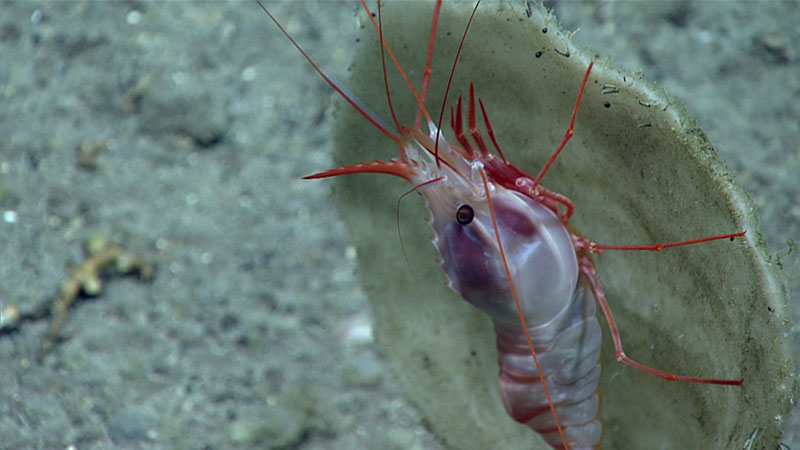
This shrimp in the genus Heterocarpus measured over 10 centimeters (4 inches) long. It was seen sitting within one of many amphitheater-shaped sponges that lined the floor of the “sponge garden” seen during the eighth dive of the 2021 North Atlantic Stepping Stones expedition. Image courtesy of NOAA Ocean Exploration, 2021 North Atlantic Stepping Stones: New England and Corner Rise Seamounts. Download largest version (jpg, 858 KB).
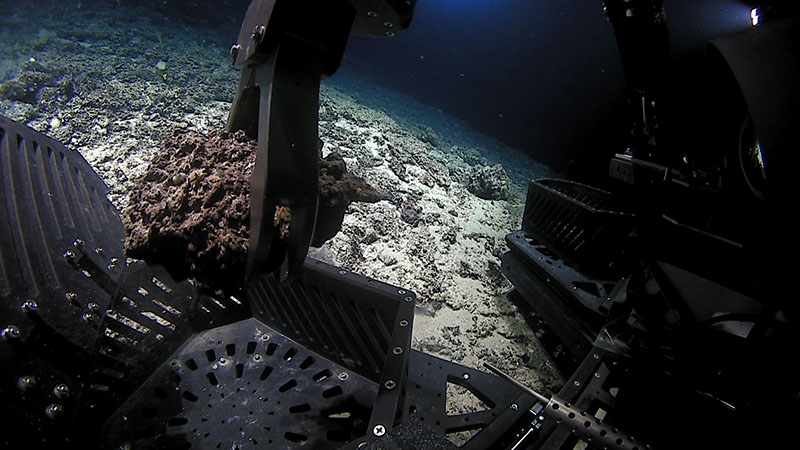
At the base of the wall feature explored during Dive 08 of the 2021 North Atlantic Stepping Stones expedition where the slope was steepening, sedimentary rocks were exposed that appeared to be carbonate conglomerate with ferromanganese coatings. A loose sample of this carbonate material was sampled. Image courtesy of NOAA Ocean Exploration, 2021 North Atlantic Stepping Stones: New England and Corner Rise Seamounts. Download largest version (jpg, 928 KB).
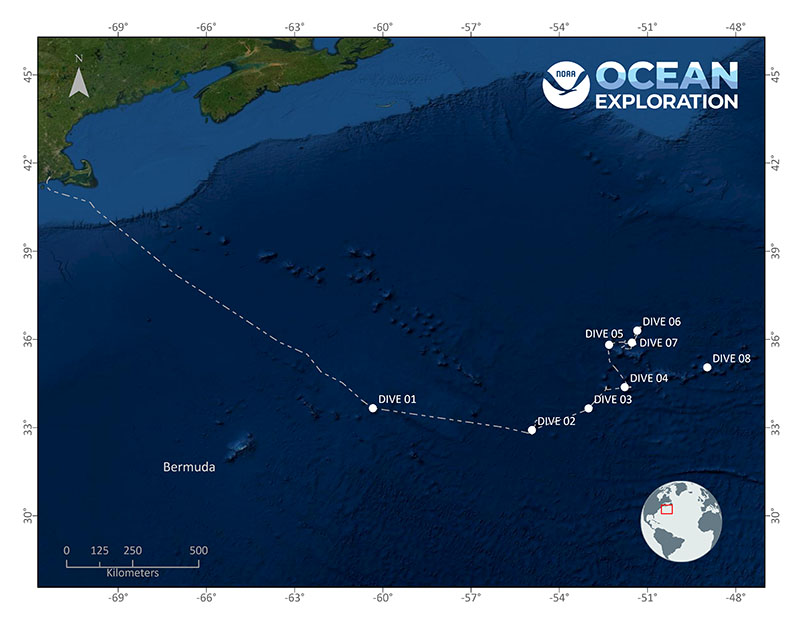
Location of Dive 08 of the 2021 North Atlantic Stepping Stones expedition on July 11, 2021. Map courtesy of NOAA Ocean Exploration, 2021 North Atlantic Stepping Stones: New England and Corner Rise Seamounts. Download largest version (jpg, 3 MB).
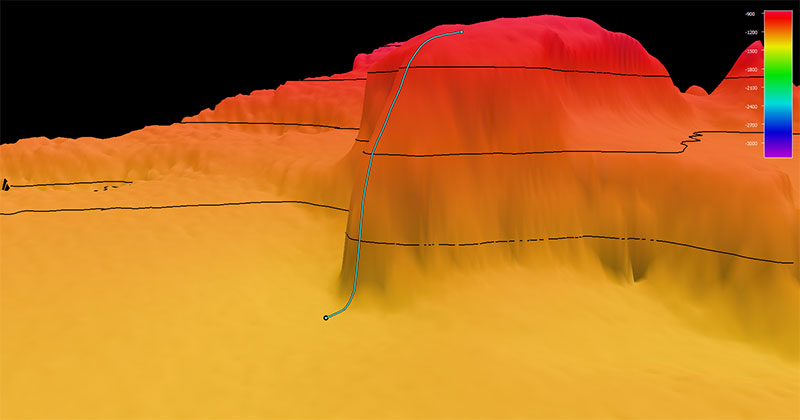
Image showing the dive track of Dive 08 of the 2021 North Atlantic Stepping Stones expedition. Scale is water depth in meters. Image courtesy of NOAA Ocean Exploration, 2021 North Atlantic Stepping Stones: New England and Corner Rise Seamounts. Download largest version (jpg, 420 KB).